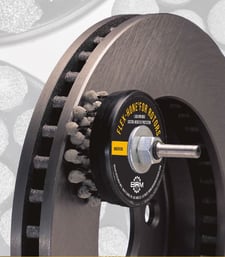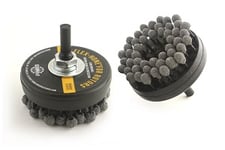 Brake rotors that lack a smooth, non-directional finish tend to wear out more quickly. Surface irregularities that produce harmonic vibrations cause brake squeaking and squealing, too. In automotive transmissions, flywheels with irregular surfaces also produce excessive noise and wear.
Brake rotors that lack a smooth, non-directional finish tend to wear out more quickly. Surface irregularities that produce harmonic vibrations cause brake squeaking and squealing, too. In automotive transmissions, flywheels with irregular surfaces also produce excessive noise and wear.
To improve the surface finish of brake rotors, flywheels, and automotive clutch plates, mechanics and manufacturers use Flex-Hone® tools from Brush Research Manufacturing (BRM). The Flex-Hone® for Rotors imparts a smooth, non-directional finish and is ideal for both new and used rotors. This flexible honing tool doesn’t require special training, but there are three keys to surface finishing success.
Avoid Excessive Material Removal
 Brake rotor specifications allow for a certain amount of wear to occur before a rotor reaches the end of its service life. If a rotor becomes too thin, however, there’s less heat absorption and greater vulnerability to cracking. Mechanics can use sandpaper or discs to resurface brake rotors, but the Flex-Hone® for Rotors is a better choice.
Brake rotor specifications allow for a certain amount of wear to occur before a rotor reaches the end of its service life. If a rotor becomes too thin, however, there’s less heat absorption and greater vulnerability to cracking. Mechanics can use sandpaper or discs to resurface brake rotors, but the Flex-Hone® for Rotors is a better choice.
BRM Flex-Hone® tools have abrasive globules that are permanently laminated to flexible nylon filaments. Through a low-temperature, low-pressure abrading process, flexible honing improves surface finish without removing significant amounts of the base material. This allows mechanics to remove brake pad “glaze” and surface rust without removing excessive amounts of metal and thinning-out the rotor.
Choose the Right Grit
Flex-Hone® for Rotors tools are available in fine, medium, and coarse grits. Choose the appropriate grit size for the amount of work to perform.
- Fine grits are recommended for light-duty vehicles, motorcycles, and other applications where brake rotors are visible and a bright finish is desired.
- Medium grits are recommended for most passenger car and light-truck applications.
- Coarse grits are recommended for flywheels, heavy-duty vehicles, and brake rotors that have been poorly turned.
Follow the Instructions
The Flex-Hone® for Rotors is designed to be held securely in a collet, chuck, or similar holding device. With brake lathes, mount the rotor securely and rotate between 125 and 210 RPMs. With a variable-speed electric drill motor or low-speed air drill, rotate the Flex-Hone® for Rotors at 300 to 600 RPM and never exceed 1000 RPM.
Apply light, uniform pressure and avoid excessive dwell time. Use the tool dry and bring the Flex-Hone® for Rotors into contact with the spinning rotors rotor at a slight angle. Work in towards the center and then out towards the rotor face. Hone for 10 to 15 seconds clockwise and then 5 to 10 seconds counterclockwise.
For more information, download the Flex-Hone® for Rotors Brochure.









